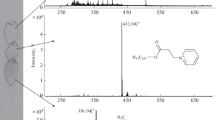Abstract
The positions of double bonds in olefins can be readily determined by a sodium borohydride reduction of their methoxymercuration products followed by mass spectrometry. Fragmentation of the methoxy derivative in the mass spectrometer results in cleavage on either side of the methoxy group to give intense fragment ions which are characteristic of each isomer. This simple and convenient microanalytical technique was applied to several synthetic standards and insect derived olefins, including the alkenes from the cuticular lipids of the honeybeeApis mellifera L.
Similar content being viewed by others
References
Abley, P., McQuillin, F.J., Minnikin, D.E., Kusamran, K., Maskens, K., andPolgar, N. 1970. Location of olefinic links in long-chain esters by methoxymercuration-demercuration followed by gas chromatography-mass spectrometry.Chem. Commun. 1970:348–349.
Baker, G.L., Vroman, H.E., andPadmore, J. 1963. Hydrocarbons of the American cockroach.Biochem. Biophys. Res. Commun. 13:360–365.
Baker, J.E., Sukkestad, D.R., Woo, S.M., andNelson, D.R. 1978. Cuticular hydrocarbons ofTribolium castaneum: Effects of the food additive tricalcium phosphate.Insect Biochem. 8:159–167.
Beatty, I.M., andGilby, A.R. 1969. The major hydrocarbon of a cockroach cuticular wax.Naturwissenschaften 56:373.
Beroza, M., andBierl, B.A. 1967. Rapid determination of olefin positions in organic compounds in microgram range by ozonolysis and gas chromatography.Anal. Chem. 39:1131–1135.
Blomquist, G.J., andRies, M.K. 1979. The enzymatic synthesis of wax esters by a microsomal preparation from the honeybeeApis mellifera L.Insect Biochem. 9:183–188.
Carlson, D.A., Mayer, M.S., Silhacek, D.L., James, J.D., Beroza, M., andBierl, B.A. 1971. Sex attractant pheromone of the housefly: Isolation, identification and synthesis. Science 174:76–78.
Cavill, G.W.K., andHoughton, E. 1973. Hydrocarbon constituents of the Argentine ant,Iridomyrmex humitis.Aust. J. Chem. 26:1131–1135.
Howard, R.W., McDaniel, C.A., andBlomquist, G.J. 1978. Cuticular hydrocarbons of the eastern subterranean termite,Reticulitermes flavipes (Kollar) (Isoptera: Rhinotermitidae).J. Chem. Ecol. 4:233–245.
Jackson, L.L. 1972. Cuticular lipids of the insects-IV. Hydrocarbons of the cockroachesPeriplaneta japonica andPeriplaneta americana compared to other cockroach hydrocarbons.Comp. Biochem. Physiol. 418:331–336.
Jackson, L.L., andArmold, M.T. 1977. Insect lipid analysis, pp. 171–206,in R.B. Turner, (ed.), Analytical Biochemistry of Insects. Elsevier, Amsterdam.
Jackson, L.L., andBlomquist, G.J. 1976. Insect waxes, pp. 201–233,in P.E. Kolattukudy, (ed.), Chemistry and Biochemistry of Natural Waxes. Elsevier, Amsterdam.
Kates, M. 1972. Techniques of lipidology—isolation, analysis and identification of lipids, pp. 267–610,in T.S. Work, and E. Work, (eds.), Laboratory Techniques in Biochemistry and Molecular Biology, Vol. 3. North Holland-American Elsevier, London.
Mody, N.V., Hedin, P.A., Neel, W.W., andMiles, P.H. 1975. Hydrocarbons from males, females and larvae of pecan weevil:Curculio caryae (Horn).Lipids 10:117–119.
Nakanishi, K. 1962. Infrared Absorption Spectroscopy—Practical. Page 233. Holden Day, San Francisco.
Nelson, D.R. 1978. Long chain methyl branched hydrocarbons: Occurrence, biosynthesis and functions.Adv. Insect Physiol. 13:1–33.
Plattner, R.D., Spencer, G.F., andKleiman, R. 1976. Double bond location in polyenoic fatty esters through partial oxymercuration.Lipids 11:222–227.
Streibl, M., andStransky, K. 1968. Uber naturwachsen IX: vorkommen, isolierung und identifizierung der Olefine in Naturwachsen.Fette-Seifen Anstrichmittel 70:343–348.
Uebel, E.C., Sonnet, P.E., Menzer, R.E., Miller, R.W., andBeroza, M., 1975a. Sex pheromone of the faceflyMusca autumnalis (De Geer) (Diptera: Muscidae).J. Chem. Ecol. 1:195–202.
Uebel, E.C., Sonnet, P.E., Bierl, B.A., andMiller, R.W. 1975b. Sex pheromone of the stable fly: Isolation and preliminary identification of compounds that induce mating strike behavior.J. Chem. Ecol. 1:377–385.
Uebel, E.C., Sonnet, P.E., andMiller, R.W. 1976. Housefly sex pheromone: Enhancement of mating strike activity by combination of (Z)-9-tricosene with branched saturated hydrocarbons.J. Econ. Entomol. 5:905–908
Uebel, E.C., Sonnet, P.E., Menzer, R.E., Miller, R.W., andLusby, W.R. 1977. Matingstimulant pheromone and cuticular lipid constituents of the little house fly,Fannia canicularis (L.).J. Chem. Ecol. 3:269–278.
Uebel, E.C., Schwarz, M., Menzer, R.E., andMiller, R.W. 1978a. Mating stimulant pheromone and cuticular lipid constituents ofFannia pusio (Wiedmann) (Diptera: Muscidae).J. Chem. Ecol. 4:73–81.
Uebel, E.C., Schwarz, M., Miller, R.W., andMenzer, R.E. 1978b. Mating stimulant pheromone and cuticular constituents ofFannia femoralis (Stein) (Diptera: Muscidae).J. Chem. Ecol. 4:83–93.
Von Endt, D.W., andWheeler, J.W. 1971. 1-Pentadecene production inTribolium confusum.Science 172:60–61.
Author information
Authors and Affiliations
Additional information
Mention of trade names or companies is solely to identify materials used and does not imply endorsement by the USDA.
Rights and permissions
About this article
Cite this article
Blomquist, G.J., Howard, R.W., McDaniel, C.A. et al. Application of methoxymercuration-demercuration followed by mass spectrometry as a convenient microanalytical technique for double-bond location in insect-derived alkenes. J Chem Ecol 6, 257–269 (1980). https://doi.org/10.1007/BF00987544
Received:
Revised:
Issue Date:
DOI: https://doi.org/10.1007/BF00987544




